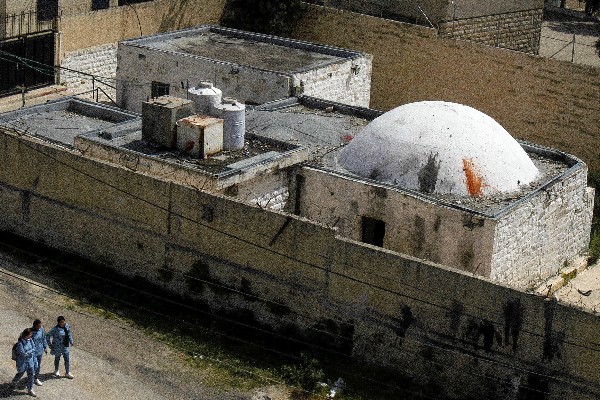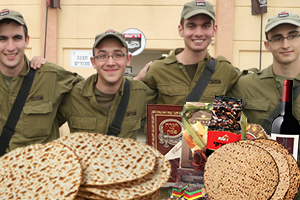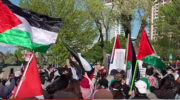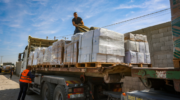Why does Joseph’s Tomb continue to attract Jewish pilgrims despite the dangers?
By David Isaac, JNS.org
Revered by Jews as the burial place of the biblical patriarch, Joseph’s Tomb, frequently a target of Arab violence, on April 9 was once again vandalized by a Palestinian mob.
Though under the Oslo agreements the tomb remained in Israeli hands despite being located in Area A of Judea and Samaria, the government abandoned the site days after a deadly attack there in Oct. 1, 2000. Following that attack, in which an Israeli Border Policeman was killed, the government decided that its location in Nablus (biblical Shechem) made it too difficult to defend.
Although the government did elicit a promise from the Palestinian Authority that the site would be protected after Israeli security forces withdrew, it was destroyed shortly afterwards.
However, two years later, security conditions in Judea and Samaria had deteriorated to the point that the Israel Defense Forces again began operating in the city. At first, small groups of Jews made risky attempts to visit the tomb, unauthorized and without IDF escort. Larger groups now enter at night, accompanied by heavy military presence.
Why does Joseph’s Tomb continue to attract Jewish pilgrims despite the dangers?
Jeffrey Woolf, professor of Talmud at Bar-Ilan University in Ramat Gan, cited three main reasons:
1) Jewish tradition considers it one of three sites in ancient Israel in which “the world will have absolutely no claims against us”;
2) A written record stretching back 1,700 years identifies the current site as Joseph’s Tomb, and, Woolf says, “we can assume an oral tradition that goes back even further”; and,
3) Joseph’s story symbolizes the Jewish people’s longing to return to their homeland.
Expounding on the first factor, Woolf said there are three places in the Bible in which a land purchase in ancient Israel is described.
The first is the Cave of Machpelah, purchased by Abraham from Ephron the Hittite as a burial place for his wife Sarah (Genesis 23). Second is the purchase of a threshing floor from Araunah the Jebusite by King David to build an altar to the Lord, which became the Temple Mount (II Samuel 24 18-25). Third is the burial place of Joseph, first mentioned as a site purchased by his father, Jacob, for a hundred pieces of silver (Genesis 33:18-20).
Woolf explains that a Talmudic-era commentary referring to that Genesis passage says that as a result of the Bible’s documentation of the purchase, “This is one of the three places of which the nations of the world cannot defraud Israel, saying that we stole them from them.”
“Of course, these are the three most contentious places in the land, so the rabbis didn’t really get it right,” said Woolf. “But the point is that these places are clearly identifiable and obviously were very well known throughout the ages.”
The plot of ground Jacob purchased in Shechem is mentioned again when the Jews finally enter the Promised Land. In the Book of Joshua (24:32), it is written: “And the bones of Joseph, which the children of Israel brought up out of Egypt, buried they in Shechem, in a parcel of ground which Jacob bought of the sons of Hamor the father of Shechem for an hundred pieces of silver: and it became the inheritance of the children of Joseph.”
This text alludes to the reason Woolf says Joseph symbolizes the connection between the Jewish people and the Land of Israel. “He had reached the pinnacle of Egyptian society, and he tells his brothers, when things are still good, ‘Listen, this is temporary and God will definitely remember us and He will take us out of Egypt and I adjure you to carry me forth. And they brought his bones out of Egypt in order to fulfill that mission.”
“He’s the ultimate example of the exile coming back to redemption in the land,” Woolf said.
The powerful story still resonates.
On April 13, commander of the Samaria Brigade Col. Roi Zweig-Lavi, the IDF officer ordered to enter the city to repair the damaged tomb, told his soldiers: “In this place, the land was promised to our forefather Abraham, as it is said, ‘To your seed I shall give this land.’”
The colonel added, “And we are operating today ‘with an outstretched arm,’ like our forefathers, about whose exodus from Egypt on Passover—which we’ll celebrate in three days—the scripture says, ‘On this very day.’ Not like thieves in the night, but as sons of kings. And so, we merit to restore the honor of the land and the people of Israel.”
The message, just before the convoy began to roll, raised eyebrows in certain quarters. Yariv Oppenheimer, a former director of Peace Now, tweeted: “What happened to the IDF? A senior officer gives a controversial nationalist religious sermon just before embarking on operational activities.”
Woolf says: “It’s hard for ‘moderns’ to understand but in traditional societies, not just Judaism, a sense of the past is very immediate. We feel it’s very accessible, emotionally and experientially. Traditionally, when Jewish people study, they always talk about people from the past in the present tense. … Joseph is a real presence, just like Rachel and Abraham are a real presence for people who visit their tombs. It’s a source of inspiration.”
Repair crews worked past dawn to finish restoring the site. (The Arab mob had done extensive damage to the electrical system, the building, which they set on fire, and the gravestone itself, which was partially smashed.) Reportedly, it was the first time Israel had maintained a daylight presence at the site since its retreat 22 years ago. The IDF convoy was attacked upon leaving. One Palestinian was killed and some 30 wounded.
Yossi Dagan, head of the Samaria Regional Council, told the press at the tomb during the repairs, “Only the State of Israel can guard this holy place.”
If past is prologue, Dagan is correct that unless Israel controls the tomb, it will again be vandalized.
• In Sept. 1996, an Arab mob attacked the tomb, killing six Israeli soldiers and wounding seven others.
• In Oct. 2000, the aforementioned border policeman bled to death from a gunshot wound as the Palestinian mob prevented rescue forces from reaching him. Once the Israeli Border Police unit left the site, the mob stormed the tomb, burning and destroying it.
• In 2015, Palestinian rioters again torched it.
• In 2016, they fired on IDF soldiers guarding 3,000 worshippers at the site.
These attacks have been punctuated by more minor desecrations through the years, as in 2009 when Jewish worshippers discovered swastikas spray-painted on the tomb.
“Unfortunately, this tomb has become a pawn in the political process,” said Joshua Schwartz, professor emeritus at the department of land of Israel studies and archaeology at Bar-Ilan University.
“Holy sites should be respected, whether they’re Christian, Jewish, or Muslim,” he said, noting that all three major monotheistic religions have recognized the sanctity of the site. “Byzantine Christians mentioned it the most, and Muslims in the Middle Ages and afterwards.”
“If they were respected, then there would be absolutely no problem, but because they are not, we have a political situation and not a religious situation. And it’s the responsibility of the State of Israel, in my view, to guarantee that sacred sites for the Jewish people should not be torched every month.”
Part of the problem, said Schwartz, who was once asked by the Shin Bet, Israel’s internal security agency, to provide a list of holy sites in Samaria, is “that the Minister of Defense, who’s in charge also of protecting holy sites, usually does not have much enthusiasm for doing so because he feels that strategically, it’s not all that important. I don’t feel that the Minister of Defense should be making these decisions because most ministers of defense have not really studied the anthropology of holy sites.”
The Real Burial Site?
Is Joseph’s Tomb the actual burial site of the biblical Joseph?
Schwartz’s answer to that question may surprise some—he says it doesn’t matter.
“We don’t know if what’s identified today as the tomb of Joseph is the tomb of Joseph. There’s no archaeological proof. But let me point out that is irrelevant. It makes absolutely no difference. Because when it comes to relics and holy sites, what’s important is not what is archaeologically true. What is important is what is believed to be true, what is accepted to be true by different communities,” he told JNS.
“The beliefs that become accepted, that’s what counts in popular and religious perception,” he stressed.
However, there are scholars who attest that the site is the correct one. Yoel Elitzur, a researcher and lecturer in the fields of biblical geography, the Bible, the Hebrew language and Semitic languages, who has made a study of Joseph’s Tomb, is one such scholar. He told JNS it’s not so much a matter of “believing as seeing.”
While Elitzur isn’t prepared to say the spot known as Joseph’s Tomb is exactly where the grave is located, he believes it’s in the area.
“The site is located at the foot of the ancient eastern gate of Shechem, exactly as described in the Bible,” he said, though he noted that “the building itself is new. There is a picture from around 1840 and there is no building at all. There’s a fence around the site.”
“Also in Kaftor Va-ferach by Rabbi Ishtori Haparchi [a scholar from the Middle Ages], writing in 1322 C.E., exactly 700 years ago, he describes a fence that surrounds it and not a building,” he said.
Elitzur said it’s unfair to say there’s no archaeological evidence as no one has dug there, and that even if they had, “what could be the archaeological evidence? There doesn’t have to be pottery. It’s a grave.”
For Elitzur, the proof is in the documentary sources, from the Bible through numerous medieval accounts, which describe the location. Those sources he details in a chapter of his book, “Places in the Parasha: Geography and Its Meaning.” One he lists is John (4:4-6): “Now, he had to go through Samaria. So he came to a town in Samaria called Sychar, near the parcel of land Jacob had given to his son Joseph. Jacob’s well was there….”
“The significance of this New Testament source is, first, the indication that the ‘parcel of land’ was a well-known place at the time the Gospel of John was written [towards the end of the first century C.E. or a little later],” writes Elitzur. Secondly, the source refers to Sychar, “identified with great certainty with the village of Askar … whose ancient center is located about 2,000 feet northeast of the modern Joseph’s Tomb.”
Elitzur said that unfortunately in the 1990s there was an effort to undermine the authenticity of the site, referring to one archaeologist in particular, Meir Ben-Dov, who claimed the structure was built during the Mamluk period only 200 years ago to honor a Muslim sheikh named Yusef, Arabic for Joseph.
Writing in the Israeli daily Haaretz in 1990, Ben-Dov wrote, “There is not even a hint of a connection between this site and the tomb of Joseph. Not one iota of information exists as to the location of Joseph’s tomb, to which, according to tradition, Joseph’s remains were brought from Egypt.”
Elitzur tells JNS that this statement flies in the face of facts on the ground and historical sources. Nevertheless, Ben-Dov’s claims were picked up and amplified by newspaper reports at the time, “which ridiculed and made fun of the idea that it was the tomb of Joseph.” Israel’s then-Education Minister Shulamit Aloni also gave several media interviews, referring to Ben-Dov, and saying the tomb was of a Sheikh Yusef. Elitzur makes the case that these statements played a role in Israel’s abandonment of the site in 2000.
“Burial sites to honor a Muslim sheikh or ‘nabi‘ [prophet] are generally placed on mountains to honor them. Joseph’s Tomb isn’t like that. It’s lower, which is in line with the description in the Bible,” said Elitzur.
He also noted that the site is east of Tell Balata, identified with the ancient city of Shechem, which was lost and unknown through the Byzantine era, the Middle Ages and the later Neapolis-Nablus period. “If someone invented the site, they’d have put it in the new city, the Nablus that is known, and not near the old city of Shechem, which they forgot,” he said.
Although Islam has co-opted Joseph and the Koran considers him a prophet, Elitzur said that, “in my opinion, they [Muslims] don’t view the tomb as a holy site.” His prima facie evidence is that they set fire to it. “It’s the best proof there is that it’s [solely] a Jewish site,” he said. “They don’t set fire to the Temple Mount or the Cave of Machpelah.”
Woolf, in explaining the Palestinian motives behind the attacks, said: “The Palestinian position is that the Jews have no place, no history, no connection with the Land of Israel. So, therefore, places like the grave of Joseph, even though Joseph is a Muslim saint, must be destroyed as they serve the claim that the Jews have a right to a home in the land of Israel.”
Send Passover Packages to Needy Israeli Soldiers - Bring Them Joy!
We are honored to thank the young men and women of the IDF who risk their lives every day to protect the citizens of Israel. Soldiers have been in Gaza, Lebanon and Syria for extended periods - many are hoping to come home for Passover.
Join us in sending Passover food packages (and personal notes) to Israeli soldiers and their families.
Many soldiers spend the Passover holiday with needy families back home. The soldiers greatly appreciate your love and concern. Bring them Passover joy!
CLICK HERE TO SEND YOUR PACKAGE AND NOTE TO ISRAELI SOLDIERS!























